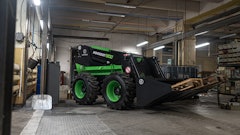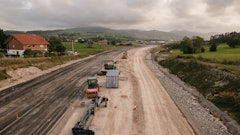
Made from renewable feedstocks, biodiesel promises to supplement the limited supply of traditional petroleum-based diesel fuel. However, it is not meant to be a direct replacement. "Biodiesel is not intended to replace diesel fuel completely, and will not be the solution on its own," says Amber Thurlo Pearson, National Biodiesel Board.
One reason is capacity constraints. "Production capacity is increasing to the tune of just under 900 million gal. of pure biodiesel," says Pearson. "Our goal is currently '5 x 2015', or 5% of on-road diesel fuel needs being met by biodiesel by 2015. That would equate to about 2 billion gal. Our current production/consumption for 2006 was at 225 million gal."
Although still far from its long-term goal, biodiesel capacity is expanding at a rapid pace, tripling in both of the last two years. According to Pearson, there were 25 million gal. produced in 2004 and 75 million gal. produced in 2005.
Technical hurdles to biodiesel's adoption stem from differences in chemistry compared to petroleum-based diesel. "If we had started with biodiesel 70 years ago and we were transferring to petroleum diesel, we would be having some of the same conversations we are having today about biodiesel," says Don Borgman, director of industry relations - North America, Deere & Co.
These differences can be mitigated by using lower blend ratios of the fuels. The most common blend is B5, a mix of 5% biodiesel and 95% petroleum-based diesel. Likewise, B20 equals 20% biodiesel content, B30 equals 30% biodiesel and so on. B100 represents pure biodiesel.
"If you took 100% concentration of [any product], it will have some impact," says Borgman. "At 5% concentration, 95% of the impact is going to be mitigated."
This is why many manufacturers recommend starting with B2 and B5 blends. "We do that to try to mitigate some of the different characteristics. We want the public to get familiar with it on a more gradual scale and not have bad experiences," says Borgman. "What we are really trying to do is get people educated and make sure all of the compatibility issues are resolved. There are some different things we need to learn to run biodiesel."
Pearson also points out that no modifications are needed to engines to run B20 blends or below.
More testing required
Biodiesel can offer some important benefits. "Biodiesel increases the lubricity of the fuel, which can result in longer fuel pump and injector life," says Kris Stearns, fuel and coolant engineer, Caterpillar.
And test data going back nearly a decade indicates it is a safe fuel. "[Caterpillar] has done testing with biodiesel starting back in the mid-1990s," says Stearns. "We have shown that our engines run well on it. In particular, some of the older engine models can run very well on even B100. There really have not been any performance issues with it."
Most manufacturers approve the use of at least B5, with no impact on the warranty as long as the fuel complies with the ASTM D 6751 specification for biodiesel. On certain engine models, blends up to B30 have been approved.
The hurdle to widespread manufacturer approval of higher blends appears to be adequate testing time for the new electronic engines.
"We are in the process of validating the biodiesel percentage that will be allowed for use in our technologically advanced 2007 on-highway diesel engines," says Stearns.
"We really want to get some testing time with the electronic engines to make sure we didn't miss anything in the analysis," agrees Richard Hall, product planning and process improvement, Case Construction Equipment. "The mechanical portions of the fuel delivery systems are very common between mechanical and electronic engines. But the electronic engines have a lot more sensors that adjust fuel based on certain engine operating parameters. That's what we are trying to monitor."
Power output
B100 biodiesel contains less energy content than petroleum-based diesel. "Round figures, you get about 140,000 BTU out of a gallon of petroleum diesel and you get about 130,000 BTU out of a gallon of 'neat' biodiesel," says Borgman.
Less BTU means lower fuel economy. "If you get to B100, you suffer a 5% to 8% energy loss in the fuel," says Hall. "That is physics. There is nothing we can do about that."
However, the power loss becomes negligible at lower blend levels. "If you go down to that B2 to B5 range, the chances are you are not going to be able to see any noticeable difference in power," Hall states. For example, if B100 were 7% less efficient, and B5 contains only 5% biodiesel, the total difference in fuel economy would be only .35%.
"When you look at the amount of fuel that gets consumed on jobsites, if I were to switch to a B100 and see a 7% or 8% BTU difference, I think I would be scratching my head a little," says Borgman. "But in those lower blend ranges of B2 or B5, I would recommend that everyone use them."
Cold weather capability
Another common concern with biodiesel is its cold temperature performance. Yet, this is a concern with No. 2 diesel fuel in general.
"Biodiesel will gel in cold temperatures, as will No. 2 diesel," says Pearson. "Up to B20 can be used year round in all types of climates if it is properly treated," says Pearson. "B20 is handled in a similar fashion to No. 2 diesel - treated with additives or by blending with No. 1 diesel for year-round operability."
The percentage of biodiesel in the blend determines how the fuel will react. "Getting up to 20% or 50%, it is going to be a little easier to notice the differences," says Borgman. But blends at lower concentrations, such as 2% to 5%, are not as much of a problem. "If you have in-spec B2 and B5 blends, then any of the normal additives you would use for cold flow improvement are going to work for you, and you should not see a difference."
However, not everyone is ready to recommend biodiesel blends for use in cold climates. Given the recent switch to ultra-low-sulfur diesel fuel (ULSD) for the on-highway market, Stearns advises a more cautious approach. "I recommend you try to limit biodiesel use in colder climates. That just throws another variable in, especially right now with the transition to ULSD," he states. "ULSD has a higher cloud point and needs more additization. [It requires] blending with ULS kerosene or with No. 1 diesel - which are not very available at the moment. Then you throw biodiesel on top of it, which has a much higher cloud point itself."
Concerns about cleansing
Equipment age also has a lot to do with biodiesel compatibility. "B100, as well as blends of increasing biodiesel content, can act as a cleansing agent to rubber components on engines older than 1994, breaking them down over time," says Pearson.
Hall agrees, adding, "The solvent nature of biofuels is definitely going to have a higher impact on some of the older materials we used to use." This is less of an issue with more current machines. "We started using more plastic types of seals in the late 1980s and early 1990s, moving away from natural rubber in a lot of our applications."
In 1993 to 1994, seal materials switched from rubber to current materials in response to lower sulfur diesel fuels, Stearns explains. "Since 2000, all of the Caterpillar product has been using Viton seals," he notes. This eliminates compatibility concerns. "As people are switching over older engines, they should watch for seal leakage or degradation."
"We suggest changing out those parts with synthetic products instead," says Pearson. "You would not need to take those precautions with a B5 blend, however."
Equipment fuel and storage tanks can also present a challenge. "Blends of biodiesel can act as a cleansing agent on sediment in the fuel system from previous regular diesel use," says Pearson. "The higher percentage of biodiesel in the blend, the higher the cleansing agent to the fuel. We recommend keeping an eye on fuel filters for the first six months of use with biodiesel blends."
The biodiesel will eventually clean up the entire fuel system. "It will dissolve anything that has been deposited, whether it is in the fuel storage tank or the fuel tank itself," says Stearns. Unfortunately, until the system is completely cleaned, the filters protecting the fuel injection pumps and injectors may plug prematurely.
"It is going to lead to having larger capacity filters or shorter service intervals, because there is definitely a relationship there," says Hall.
Again, both of these issues are mitigated at the lower blend levels.
Proper handling
As the percentage of biodiesel increases in the fuel, so do the necessary precautions for storage and maintenance.
"We have very clear guidelines as to how you should treat the fuel, as well as service the [equipment]. Watch the amount of water in the fuel. Don't let it sit idle for longer periods of time. Carefully monitor the condition of your oil," Hall advises. "If you follow those guidelines, I don't think there will be any impact on [equipment] performance. But you do have to pay much more attention to that than you would with petroleum-based diesel."
This is because biodiesel is more prone to water absorption. "So care must be taken in order to remove water from the fuel system, because water accelerates microbial contamination and growth," says Stearns.
Hall recommends draining water out of the fuel/water separators on a more regular basis. "It is just an education process here that we want customers to be aware of so they don't get caught with clogged filters, lower performance or rusting in the fuel system," he states. "We have a procedure that we specify they follow if they want to use biodiesels."
Economic incentives
Ultimately, tax incentives may prove to be the major market driver behind adoption of renewable biodiesel blends.
"There are obvious tax incentives, depending upon what state you are operating in," says Stearns.
And more could be in the works. "There is talk of some really nice incentives if they could use biofuels," says Hall. "That certainly would have to happen in order for our customers to get really highly motivated. We are really looking for the federal government to take some actions here."
In terms of outright pricing, the difference fluctuates. "B20 currently sells anywhere from the same price as diesel up to $.20 more a gallon," says Pearson. "How competitive it is with diesel depends largely on the price of oil."
"If oil prices are going to stay where they are right now, it is kind of a wash on the price of biodiesel and the price of regular diesel," notes Stearns. "But if we get in another situation like we did last summer when diesel was up over $3/gal., then there is obvious economic sense."
A promising outlook
Right now, everyone has a vested interest in the success of biodiesel, and the future does look promising. Still, equipment manufacturers urge caution with higher blends.
"We have spent a lot of money and time over the last couple of years testing at the B20 level to absolutely confirm whether there are any [equipment] modifications required," says Borgman. "That is ongoing work and we do not have the results of that yet. It would obviously be our desire to recommend at higher levels, but we need solid test data that we have absolute confidence in."
Once those results come in, biodiesel is positioned to play an even more significant role, particularly as the industry matures and new technology becomes available.
"At this point in time, I think it would be foolish for any of us to say there is an absolute cap or ceiling," says Borgman. "This is a very new industry. There are some very promising things going on out there."
Ensure a Quality Fuel Supply But there are a couple of steps you can take to ensure a quality fuel supply. "We strongly recommend you use only a biodiesel blend that comes from a BQ-9000 supply chain - both the biodiesel refinery where it is manufactured, as well as the distributor that brings your fuel out to the work site," says Don Borgman, Deere & Co. It must also meet the ASTM D 6751 specification for biodiesel. "Although there are currently about two dozen BQ-9000 accredited producers and marketers, they represent 40% of the industry's capacity," says Amber Thurlo Pearson at the National Biodiesel Board. "Asking around or calling the BQ-9000 companies directly (www.BQ-9000.org) to find out where to get their product can help ensure your fuel meets ASTM D 6751. Further, the National Biodiesel Board is working with appropriate state and federal officials on proactively enforcing any biodiesel fuel quality issues." (Visit www.biodiesel.org for a fuel quality guide.) |






























